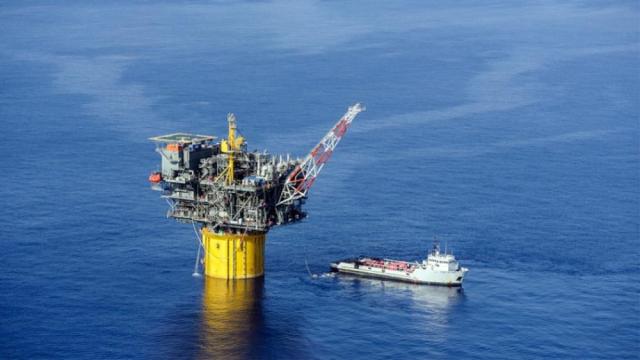
Hess Corp. is developing Esox as a tieback to the Tubular Bells production facility. (Source: Hess Corp.)
Learn more about Hart Energy Conferences
Get our latest conference schedules, updates and insights straight to your inbox.
With subsea installation underway and dual completion run successfully, Hess Corp. said the Esox-1 discovery will be brought online next month in the U.S. Gulf of Mexico (GoM), one of the company’s main cash engines.
“Esox is a high-return, cash-generative tieback opportunity that was well executed,” Hess COO Greg Hill said Jan. 29 on the company’s fourth-quarter 2019 earnings call. “The timeframe from discovery to first oil is expected to be less than four months.”
The New York-headquartered company shared news of the deepwater GoM discovery in Mississippi Canyon Block No. 726 in October. The well is located east of the Tubular Bells production facility, to which it will be tied. Esox is expected to contribute barrels to Hess’ forecasted net production of an average 65,000 barrels of oil equivalent per day (boe/d) this year in the GoM.
Activity in the GoM has steadily strengthened since the oil market downturn sparked a spending slowdown about five years ago. Tough times prompted some players to sell interests in offshore assets but it also motivated others to operate more efficiently, including through infrastructure-led exploration, subsea tiebacks and use of existing infrastructure.
“We see four to six more things that we’d like to drill in the next couple years in our expectation of keeping those hubs full. Then beyond that, of course, it will be greenfield,” Hill said. “So, we’ll drill a greenfield exploration well, probably one a year on average over the next several years, trying to maintain that production or potentially even growing it with a new hub.”
Analysts at Rystad Energy have pointed out favorable breakeven prices for some greenfield commitments offshore, noting offshore sanctioning worldwide could build on the last year’s success.
The Norway-based energy consultancy forecasts nearly $60 billion worth of the expected greenfield commitments globally in 2020 are for fields with breakevens below $40 per barrel.
“However, close to $55 billion worth of projects have breakeven oil prices above $40 per barrel,” Rystad said in a January report on offshore projects. “Despite current engineering efforts supporting the timing of these funding decisions, the ability of the oil and gas companies’ project teams to further reduce costs will greatly influence the number of actual commitments in 2020 and beyond.”
The U.S. Energy Information Administration forecast crude oil production in the GoM to rise to an average 2 million barrels per day (MMbbl/d) this year, up from 1.9. MMbbl/d in 2019.
The projected increase doesn’t mean its smooth sailing ahead for offshore, which must consider planned maintenance shutdowns and unplanned weather-related shutdowns’ impact on production.
Hess reported Jan. 29 its net production from the GoM was 70,000 boe/d in the third quarter, which was up from 68,000 boe/d a year earlier.
Extended maintenance shutdowns are planned for second-quarter 2020. Anticipated production estimates take these into account.
The two major shutdowns, both lasting about 30 days, are at the Conger Field and Llano Field, Hill said. There’s also an approximately eight-day shutdown at the Penn State Field.
Combined, “the net impact of that on the quarter is about 13,000 barrels a day,” he said.
Analysts with CapitalOne Securities Inc. suggested this, along with news of some expected downtime in the Bakken, were behind Hess’ recent market underperformance. Hess’ stock was down by 6.75% to $57.93 just after 2 p.m. CT Jan. 29.
“HES issued 2020 CAPEX and boe production guidance yesterday before the [market] opened, so we don’t think the reaction relates to 2020 guidance,” analysts said in a note. “However, the incremental color on the call suggests that oil [volumes] could potentially disappoint and/or there may be some added risk to production guidance that the [market] was not aware of yesterday [Jan. 28].”
For 2019, the company said its overall net oil and gas production—excluding Libya—was 290,000 boe/d, led by growth in the Bakken.
In all, Hess forecasts its net production will range from 330,000 to 335,000 boe/d this year. With an E&P capex budget of $3 billion for 2020, Hess plans to spend more than the estimated $2.7 billion budgeted in 2019. Most of it will go toward assets in the Bakken and offshore Guyana, where it is a partner in the Exxon Mobil Corp.-led consortium that has made 16 discoveries on the Stabroek Block.
Production spend in the deepwater GoM will be about $135 million, down from about $290 million last year, a Hess executive said, noting more rigs were running then at the Stampede Field.
While most of the $450 million set aside for companywide exploration and appraisal drilling this year will be for wells on the Stabroek and Kaieteur blocks offshore Guyana, some of the capital will fund two GoM exploration wells as well as seismic acquisition and processing, the company said.
“Going forward, you can expect about $150 [million] to $200 million in capex per annum for infill and tieback wells,” Hill said of the GoM, adding the company aims to maintain GoM production at about 65,000 bbl/d. “And we’ve been very successful doing that.”
Recommended Reading
enCore Energy Appoints Robert Willette as Chief Legal Officer
2024-02-01 - enCore Energy’s new chief legal officer Robert Willette has over 29 years of corporate legal experience.
Laredo Oil Subsidiary, Erehwon Enter Into Drilling Agreement with Texakoma
2024-03-14 - The agreement with Lustre Oil and Erehwon Oil & Gas would allow Texakoma to participate in the development of 7,375 net acres of mineral rights in Valley County, Montana.
Hess Corp. Boosts Bakken Output, Drilling Ahead of Chevron Merger
2024-01-31 - Hess Corp. increased its drilling activity and output from the Bakken play of North Dakota during the fourth quarter, the E&P reported in its latest earnings.
Petrie Partners: A Small Wonder
2024-02-01 - Petrie Partners may not be the biggest or flashiest investment bank on the block, but after over two decades, its executives have been around the block more than most.
CEO: Magnolia Hunting Giddings Bolt-ons that ‘Pack a Punch’ in ‘24
2024-02-16 - Magnolia Oil & Gas plans to boost production volumes in the single digits this year, with the majority of the growth coming from the Giddings Field.






